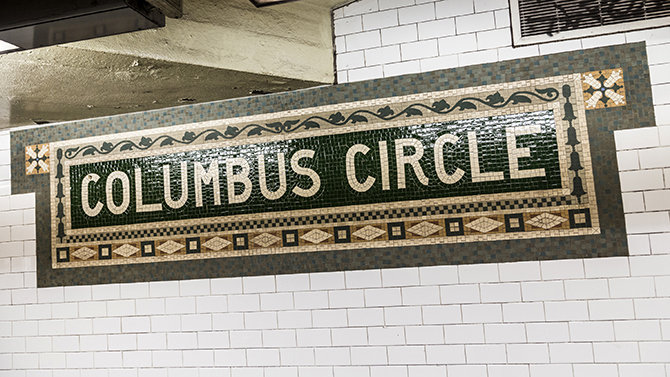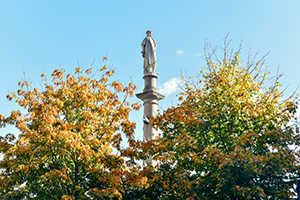REMEMBERING CHRISTOPHER COLUMBUS

By Clint Brownfield
Those of us who live in and love New York City consider the city to be the center of the world. Our tremendous diversity has and continues to make this a fact. Year after year, century after century, people from all over the world, sometimes in waves, arrived (and still do!) to make the city their home. Many Italians are certainly in that number with Giovanni da Verrazzano leading the way in 1524 when he first sailed into New York Harbor. True, Verrazzano may link Brooklyn and Staten Island with a bridge, but there’s another Italian who reigns supreme in this city at 59th Street and Eight Avenue—otherwise known as Columbus Circle.
HONORING THE EXPLORER
Born in Genoa, Italy in 1451, Christopher Columbus would live to complete four voyages across the Atlantic Ocean. He died in Valladolid, Spain, May 20, 1506. Although he never made it up to what is now New York City, he is remembered each October via a U. S. federal holiday, to commemorate his first landing in the New World in 1492.
According to The Washington Post, the first Columbus Day celebration recorded in the United States was in New York on October 12th, 1792, held to honor Italian-American heritage. President Franklin Delano Roosevelt in 1937 proclaimed October 12th to be Columbus Day, a national holiday. In 1971, the holiday date was changed to the second Monday in October.

A LOOK AT THE LANDMARK
Though it’s not technically true, Columbus Circle is considered to be the geographic center of the city because all official distances from New York City are recorded using the Columbus statue as the starting point.
Like many landmarks in the city, Columbus Circle has evolved and changed through the years. Located at the southwest corner of Central Park, the Circle was included in the original plans of Frederick Law Olmsted and Calvert Vaux. They wanted to include a traffic circle at the park’s Merchants’ Gate entrance at Eighth Avenue. But, credit for designing the traffic circle, which opened in 1905, goes to traffic safety pioneer William P. Eno, whose other achievements include the rotary traffic plans around the Arc de Triomphe in Paris, and Piccadilly Circus in London.
But, the circle’s centerpiece was already there—the monument to and statue of Christopher Columbus, by Roman sculptor Gaetano Russo. It was gifted to the City of New York in 1892 by Italian-Americans of New York in honor of the 400th anniversary of Columbus’s first voyage to the Americas. When the statue’s cornerstone was laid on September 17, 1892, there was a procession from Little Italy up to the Circle. The statue atop the monument was dedicated on October 12th, 1892.
The 76-foot Columbus Column monument at the center of the circle consists of a 14-foot marble statue of Columbus atop a 27.5-foot granite column on a four-stepped granite pedestal. The column is decorated with bronze reliefs representing the explorer’s ships—the Niña, Pinta, and Santa María. Purists will notice they are Roman galleys instead of caravels; its pedestal features an angel holding a globe.
If you work, shop, or enjoy the many restaurants in this area you will probably travel through the 59th Street Columbus Circle station—the sixth busiest subway complex in the city, with 23.2 million riders each year. When you exit, give a nod to Christopher Columbus, who to this day proudly stands at the center of world.



